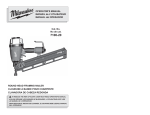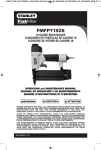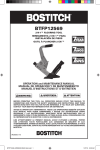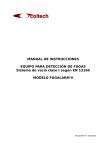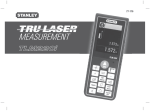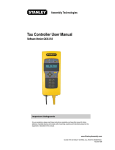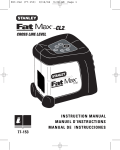Download Bostitch CRN38K Specifications
Transcript
CRN38K CORDLESS ROOFING NAILER CLAVADORA DE TECHOS A PILAS CLOUEUSE DE TOIT SANS FIL OPERATION and MAINTENANCE MANUAL MANUAL DE OPERACIÓN Y MANTENIMIENTO MANUEL DE FONCTIONNEMENT ET D’ENTRETIEN BEFORE OPERATING THIS TOOL, ALL OPERATORS SHOULD STUDY THIS MANUAL TO UNDERSTAND AND FOLLOW THE SAFETY WARNINGS AND INSTRUCTIONS. KEEP THESE INSTRUCTIONS WITH THE TOOL FOR FUTURE REFERENCE. IF YOU HAVE ANY QUESTIONS, CONTACT YOUR STANLEY-BOSTITCH REPRESENTATIVE OR DISTRIBUTOR. ANTES DE OPERAR ESTA HERRAMIENTA, TODOS LOS OPERADORES DEBERÁN ESTUDIAR ESTE MANUAL CON EL FIN DE COMPRENDER Y SEGUIR LAS ADVERTENCIAS DE SEGURIDAD Y LAS INSTRUCCIONES. MANTENGA ESTAS INSTRUCCIONES CON LA HERRAMIENTA PARA REFERENCIA FUTURA. SI USTED TIENE ALGUNA PREGUNTA, PÓNGASE EN CONTACTO CON SU REPRESENTANTE O DISTRIBUIDOR DE STANLEY-BOSTITCH. AVANT D’UTILISER CET OUTIL, TOUS LES UTILISATEURS DEVRAIENT ÉTUDIER CE MANUEL POUR COMPRENDRE ET SUIVRE LES INSTRUCTIONS ET LES AVERTISSEMENTS DE SÉCURITÉ. GARDEZ CES INSTRUCTIONS AVEC L’OUTIL POUR VOUS Y RÉFÉRER À L’AVENIR. POUR TOUTE QUESTION, PRENEZ CONTACT AVEC VOTRE REPRÉSENTANT OU DISTRIBUTEUR STANLEY-BOSTITCH. 110504 REVB 12/00 Stanley Fastening Systems INTRODUCTION The Stanley-Bostitch CRN38 is a precision-built tool, designed for high speed, high volume nailing. These tools will deliver efficient, dependable service when used correctly and with care. As with any fine power tool, for best performance the manufacturer’s instructions must be followed. Please study this manual before operating the tool and understand the safety warnings and cautions. The instructions on installation, operation and maintenance should be read carefully, and the manual kept for reference. NOTE: Additional safety measures may be required because of your particular application of the tool. Contact your Stanley-Bostitch representative or distributor with any questions concerning the tool and its use. Stanley-Bostitch, Inc., East Greenwich, Rhode Island 02818. INDEX Safety Instructions . . . . . . . . . . . . . . . . . . . . . . . . . . . . . . . . . . 3,4 Loading the Tool . . . . . . . . . . . . . . . . . . . . . . . . . . . . . . . . . . . 4,5 Tool Operation . . . . . . . . . . . . . . . . . . . . . . . . . . . . . . . . . . . . 5-7 Trouble Shooting . . . . . . . . . . . . . . . . . . . . . . . . . . . . . . . . . . . . 8 Cleaning Instructions . . . . . . . . . . . . . . . . . . . . . . . . . . . . . . . . . 9 Maintaining the Tool . . . . . . . . . . . . . . . . . . . . . . . . . . . . . . . . . . 9 Accessories . . . . . . . . . . . . . . . . . . . . . . . . . . . . . . . . . . . . . . 10 NOTE: Stanley-Bostitch tools have been engineered to provide excellent customer satisfaction and are designed to achieve maximum performance when used with precision Stanley-Bostitch fasteners engineered to the same exacting standards. Stanley-Bostitch cannot assume responsibility for product performance if our tools are used with fasteners or accessories not meeting the specific requirements established for genuine Stanley-Bostitch nails, staples and accessories. LIMITED WARRANTY Stanley-Bostitch, Inc., warrants to the original retail purchaser that this product is free from defects in material and workmanship, and agrees to repair or replace, at Stanley-Bostitch's option, any defective product within 1 year from the date of purchase. This warranty is not transferable. It only covers damage resulting from defects in material or workmanship, and it does not cover conditions or malfunctions resulting from normal wear, neglect, abuse, accident or repairs attempted or made by other than our regional repair center or authorized warranty service center. Driver blades, bumpers and o-rings are considered normally wearing parts. THIS WARRANTY IS IN LIEU OF ALL OTHER EXPRESS WARRANTIES. ANY WARRANTY OF MERCHANTABILITY OR FITNESS FOR A PARTICULAR PURPOSE IS LIMITED TO THE DURATION OF THIS WARRANTY. STANLEY-BOSTITCH SHALL NOT BE LIABLE FOR ANY INCIDENTAL OR CONSEQUENTIAL DAMAGES. This warranty is limited to sales in the United States and Canada. Some states do not allow limitations on how long an implied warranty lasts, or the exclusion or limitation of incidental or consequential damages, so the above limitations or exclusions may not apply to you. This warranty gives you specific legal rights, and you may also have other rights which vary from state to state. To obtain warranty service, return the product at your expense together with proof of purchase to a Stanley-Bostitch Regional or authorized warranty repair center. You may call us at 1-800-556-6696 for the location of authorized warranty service centers in your area. -2- SAFETY INSTRUCTIONS EYE PROTECTION which conforms to ANSI specifications and provides protection against flying particles both from the FRONT and SIDE should ALWAYS be worn by the operator and others in the work area when loading, operating or servicing this tool. Eye protection is required to guard against flying fasteners and debris, which could cause severe eye injury. The employer and/or user must ensure that proper eye protection is worn. Eye protection equipment must conform to the requirements of the American National Standards Institute, ANSI Z87.1-1989 and provide both frontal and side protection. NOTE: Non-side shielded spectacles and face shields alone do not provide adequate protection. CAUTION: Additional Safety Protection will be required in some environments. For example, the working area may include exposure to noise level which can lead to hearing damage. The employer and user must ensure that any necessary hearing protection is provided and used by the operator and others in the work area. Some environments will require the use of head protection equipment. When required, the employer and user must ensure that head protection conforming to ANSI Z89.1 1986 is used. Always disconnect battery: 1.) Before making adjustments; 2.) When servicing the tool; 3.) When clearing a jam; 4.) When tool is not in use; 5.) When moving to a different work area, as accidental actuation may occur, possibly causing injury. OPERATION Always handle the tool with care: 1.) Never engage in horseplay; 2.) Never pull the trigger unless nose is directed toward the work; 3.) Keep others a safe distance from the tool while tool is in operation as accidental actuation may occur, possibly causing injury. The operator must not hold the trigger pulled except during fastening operation as injury could result if the trip accidentally contacted someone or something, causing the tool to cycle. Keep hands and body away from the discharge area of the tool. Do not drive fasteners close to the edge of the work piece as the wood may split, allowing the fastener to be deflected possibly causing injury. Do not operate tool in explosive atmospheres such as in the presence of flammable gases, liquids or dust. This tool creates sparks which can ignite fumes or dust. MAINTAINING THE TOOL When working on cordless tool note the warnings in this manual and use extra care when evaluating problem tools. BATTERY/CHARGER • To reduce risk of injury, only charge Model BP20419 nickel cadmium batteries with the Model BC20419 Charger. Other types of batteries may burst causing personal injury and damage. • Do not expose Charger to rain, snow or frost. • Do not abuse the Charger line cord. Disconnect from receptacle by pulling the plug rather than cord. Locate cord so that it will not be stepped on, tripped over, or otherwise subjected to damage or stress. • Do not use an extension cord unless absolutely necessary. Use of improper extension cord could result in a risk of fire and electric shock. If an extension cord must be used, make sure: a) that blades on plug of extension cord are the same number, size and shape as those of plug on charger b) that extension cord is properly wired and in good electrical condition c) that wire size is at least 16 gauge (AWG) If the charger is used outdoors with an extension cord, the cord should be suitable for outdoor use. Suitable cords are marked with "W" or "WA" on the jacket and it is recommended that they be listed by the Underwriters Laboratories Inc. (UL). • Do not operate the Charger with a damaged line cord or plug – have these replaced immediately. -3- • Do not operate the Charger if it has received a sharp blow, been dropped or otherwise been damaged in any way. Do not disassemble the charger; refer to the Bostitch Service Center or a qualified service technician for service or repair. Incorrect re-assembly may result in a risk of electric shock or fire. • Unplug the Charger from outlet to reduce the risk of electric shock while cleaning or attempting any maintenance. • Unplug the Charger from outlet when it is not being used. • When batteries are not installed in the CRN38, keep them away from nails or other metal objects that may short circuit the terminals. Do not place batteries in pockets or toolboxes with nails, screws or other metal objects. This may cause fire or injury. • To reduce risk of explosion and injury, do not place battery packs in a fire or incinerator. • Do not disassemble or mutilate the battery pack, the cells contain chemicals that can cause burns. SAFETY SAVE THESE INSTRUCTIONS • This manual contains important safety and operating instructions for using the Bostitch Model BC20419 Battery Charger and the Bostitch Model BP20419 Battery Pack. • Before Using Tool, Battery, and Charger, read all instructions and cautionary markings on Battery Charger, Battery Pack, and CRN38 Roofing Nailer. LOADING THE CRN38 EYE PROTECTION which conforms to ANSI specifications and provides protection against flying particles both from the FRONT and SIDE should ALWAYS be worn by the operator and others in the work area when loading, operating or servicing this tool. Eye protection is required to guard against flying fasteners and debris, which could cause severe eye injury. The employer and/or user must ensure that proper eye protection is worn. Eye protection equipment must conform to the requirements of the American National Standards Institute, ANSI Z87.1-1989 and provide both frontal and side protection. NOTE: Non-side shielded spectacles and face shields alone do not provide adequate protection. TO PREVENT ACCIDENTAL INJURIES: • Never place a hand or any other part of the body in nail discharge area of the tool while the battery is connected. • Never point the tool at anyone else. • Never engage in horseplay. • Never pull the trigger unless nose is directed at the work. • Always handle the tool with care. • Do not pull the trigger or depress the trip mechanism while loading the tool. READ AND UNDERSTAND BEFORE OPERATING Nail Loading / unloading Loading: To load the tool, unlatch the door and rotate. Open the door and canister holder. Pull about 3" of fasteners out of the canister, and load the canister into the holder. Rotate the holder to the operating position. Place the lead fastener into the drive channel of the nose. Close the door and check that it is latched. Unloading is the reverse of loading. -4- BATTERY PACK OPERATION CHARGING THE BATTERY PACK • IMPORTANT – Charge the battery packs before using for the first time since they are shipped in a partially charged condition. Two or three additional charges will be required before the battery packs are fully conditioned and operating at full capacity. • For best results charge the batteries in an ambient temperature between 40°F and 105°F. • Batteries that have been used in the CRN38 for extended periods of time will become hot. If they are hot when placed on the charger, the red charge indicator flashes until the battery cools to a temperature that is safe for charging. This cool off time will depend on the battery and ambient temperatures and can range from a few minutes to over 30 minutes. When the battery has cooled, the charger will automatically switch to the Rapid Charge mode. • Use care when installing and removing the battery from the tool, do not press the trigger or the tool may activate. Be sure to first remove the battery from the CRN38 before cleaning the nose or removing it for service. STORAGE • To get the longest battery life, ensure that the battery packs are discharged before being stored for long periods (more than one month). Batteries can be stored in a dry location at any temperature between –20°F and 120°F. They should be recharged before being used again. BATTERY DISPOSAL • Nickel cadmium batteries are recyclable and should be disposed of properly. Many state and local laws make it illegal to dispose of these battery packs in normal trash or land fill facilities. Recycle the batteries by dropping them off at local battery replacement retailers or recycling centers. Look for the RBRC emblem. Call 1-800-8-BATTERY for information about nickel cadmium battery recycling and disposal. Installation and Removal • The battery is installed on the CRN38 Roofing Nailer by placing it on the rails and sliding it forward until the latch engages. • To remove, release the latch and at the same time slide the battery off the rails. Battery Latch TOOL OPERATION EYE PROTECTION which conforms to ANSI specifications and provides protection against flying particles both from the FRONT and SIDE should ALWAYS be worn by the operator and others in the work area when loading, operating or servicing this tool. Eye protection is required to guard against flying fasteners and debris, which could cause severe eye injury. The employer and/or user must ensure that proper eye protection is worn. Eye protection equipment must conform to the requirements of the American National Standards Institute, ANSI Z87.1-1989 and provide both frontal and side protection. NOTE: Nonside shielded spectacles and face shields alone do not provide adequate protection. • The CRN38 is a contact trip operated tool. • For best operation hold the trigger in and press the tool against the work surface. Make sure to push down until the tool stops against the work surface and turns off. • The tool should be held perpendicular to the work surface or leaned back slightly. -5- • For best operation hold the tool as you would a screwdriver or drill driver as shown. • It is not necessary to push the tool hard, simply follow the nail down. NOTE: Head damage and incomplete drives will result if the tool is pushed hard. • The tool will drive the nail quickly (less than .25 seconds). For optimum battery life push the tool down quickly. The operator must not hold the trigger pulled except during fastening operation, as serious injury could result if the trip accidentally contacted someone or something, causing the tool to cycle. Keep hands and body away from the discharge area of the tool. COLD WEATHER OPERATION: For cold weather operation, near and below freezing, the tool may slow down in operation and battery capacity will be reduced. Do not store tools in a cold weather environment to prevent frost or ice formation on the tools operating mechanisms that could cause tool failure. ENERGY ADJUSTMENT/FASTENER DEPTH CONTROL Adjusting Wheel • Fastener drive depth adjustment is accomplished by rotating the adjustment wheel of the Energy Management System. • Rotate the wheel counterclockwise for deeper drives, clockwise for less depth. • Thicker layers of shingles generally require more depth of drive. • Unless the shingles are hot the tool can typically be used at the maximum setting without overdriving and damaging the shingles. • To optimize the number of fasteners per charge, adjust the energy management system so the driven nails are flush with the shingle surface on the lowest setting possible. TOOL OPERATION CHECK Remove all fasteners from tool before performing tool operation check. Contact Trip OPERATED TOOL: With finger off the trigger, press the contact trip against the work surface. THE TOOL MUST NOT CYCLE. Hold the tool off the work surface, and pull the trigger. THE TOOL MUST NOT CYCLE. With the tool off the work surface, pull the trigger. Press the contact trip against the work surface. THE TOOL MUST TURN ON. Without touching the trigger, press the contact trip against the work surface, then pull the trigger. THE TOOL MUST TURN ON. THE TOOL WILL CYCLE EACH TIME THE TRIGGER IS PULLED! -6- CHARGER OPERATION NORMAL CHARGING: • Plug the charger into a 120V AC outlet. Insert the battery pack onto the charger ramp; press firmly to seat completely. The red indicator will begin to flash and after a few seconds will light continuously. When the charge is complete, the red indicator will go off and the green indicator will come on. The battery pack can now be removed and installed in the tool. • Charge battery packs in a well-ventilated area. The charger housing has several ventilation openings. These must remain open for proper charger operation. Do not obstruct these openings or place charger on any surface that will block air from flowing through the charger housing. Do not cover the charger or battery with a cloth or other cover while charging. • The battery can be left on the charger after full charge has been reached. The battery will continue to be charged at a low, trickle rate. • If the CRN38 and battery packs are not going to be used within a week, battery life will be extended by taking them off the charger. Recharge the battery packs before using again. • Normal charging time is between 10 and 60 minutes. This will vary depending on the charge that is needed. If the battery has only been partially discharged, the full 60-minute charge will not be required. • It is normal for the charger to hum and become warm to the touch during charging, this does not indicate a problem. FUNCTION OF CHARGER INDICATORS • Flashing Red Indicator – when the battery pack is first placed on charger, it is being analyzed before starting the Rapid Charge mode. Normally the indicator will change to steady red after a few seconds, showing that rapid charging has begun. However, if the indicator continues flashing, the battery pack may be too hot or may have been over discharged. Battery pack condition will be monitored and the charger will switch to the Rapid Charge mode when ready. At that time, the steady red indicator will be seen. • Steady Red Indicator – the battery pack is in the Rapid Charge mode. Depending on the battery pack condition, the charge mode will normally last up to one hour. • Steady Green Indicator – the Rapid Charge mode has ended and the battery pack can be removed for use in the tool. The battery pack can also be left in the charger and a small Trickle Charge current will keep the battery pack fully charged. SHINGLE GUIDE SHINGLE GUIDE ADJUSTMENT • Loosen locking screw using the 3mm wrench. • Slide the guide to set the desired exposure 5" - 6 1/2" • For longer exposure, remove the guide and reverse it. • Tighten the locking screw. IN ADDITION TO THE OTHER WARNINGS CONTAINED IN THIS MANUAL OBSERVE THE FOLLOWING FOR SAFE OPERATION • Use the STANLEY-BOSTITCH cordless tool only for the purpose for which it was designed. • Never use this tool in a manner that could cause a fastener to be directed toward the user or others in the work area. • Do not use the tool as a hammer. • Always carry the tool by the handle. • Do not alter or modify this tool from the original design or function without approval from STANLEY-BOSTITCH, INC. • Always be aware that misuse and improper handling of this tool can cause injury to yourself and others. • Never clamp or tape the trigger in an actuated position. • Never leave a tool unattended with the battery pack attached. • Do not operate this tool if it does not contain a legible WARNING LABEL. • Do not continue to use a tool that does not function properly. Notify your nearest StanleyBostitch representative if your tool continues to experience functional problems. -7- TROUBLE SHOOTING PROBLEM CAUSE CORRECTION CHARGER No lights turn on Not plugged in properly . . . . . . . . . . . . . . . . . . .Plug in the charger Battery is not fully inserted into charger . . . . . .Make sure battery is pushed all the way into charger Charger has failed . . . . . . . . . . . . . . . . . . . . . .Replace Red lights stay flashing Battery is too hot, or cold . . . . . . . . . . . . . . . . .Warm or cool as needed, or allow battery to stay on charger until temperature normalized Battery is completely drained . . . . . . . . . . . . . .Leave battery in charger, charger will start when trickle charge has brought battery voltage up enough to allow charging to begin TOOL Tool won't drive fastener Tool is not being fully pressed to work . . . . . . . .Depress tool fully while driving a nail (tool does not surface . . . . . . . . . . . . . . . . . . . . . . . . . . . . . . .bump fire) Fasteners won't feed Fastener coil damaged in canister . . . . . . . . . . .Check if fasteners exit smoothly, if not then replace coil Tool is not being fully cycled . . . . . . . . . . . . . . .Make sure tool is depressed completely during drive Fastener is caught in the nose . . . . . . . . . . . . .Open door and clear jam, and straighten any distorted collation Feed torsion spring has failed . . . . . . . . . . . . . .Replace spring Feed delay lever or spring has failed . . . . . . . . .Replace lever or spring (See parts list) Tool won't turn off Energy management system failed . . . . . . . . . .Service tool, replace energy management system Tool won't turn on Battery installed incorrectly . . . . . . . . . . . . . . . .Make sure battery is fully inserted onto tool Battery is completely drained . . . . . . . . . . . . . .Charge battery Nose switch is out of position . . . . . . . . . . . . . .Service tool, replace wire harness Trigger or nose switch has failed . . . . . . . . . . . .Service tool, replace wire harness Energy management system failed . . . . . . . . . .Service tool, replace energy management system Tool seems slow or under powered Battery is drained . . . . . . . . . . . . . . . . . . . . . . .Charge battery Driver or driver guide is full of tar . . . . . . . . . . . .Remove nose and driver guide and clean with solvent O-rings are worn out . . . . . . . . . . . . . . . . . . . . .Replace o-rings Driver is binding in nose . . . . . . . . . . . . . . . . . .Service tool Tar build up . . . . . . . . . . . . . . . . . . . . . . . . . . . .Clean nose and driver guide Battery is too cold . . . . . . . . . . . . . . . . . . . . . . .Warm as needed, or allow battery to stay on . . . . . . . . . . . . . . . . . . . . . . . . . . . . . . . . . . . . .charger until temperature is normalized Battery goes dead quickly Battery has not been charged in a long time . . .Charge battery Battery charger shuts off early . . . . . . . . . . . . . .Repeat, if problem continues replace charger Battery won't hold charge . . . . . . . . . . . . . . . . .Replace battery Tool power setting is too high . . . . . . . . . . . . . .Reduce power until depth of drive is just being achieved Nail heads are damaged during drive Tool is being pushed down too hard . . . . . . . . .Use light push force to follow the nail in Tool is being held improperly . . . . . . . . . . . . . . .For best operation hold tool at top of handle, see figure in operation section Nails are incompletely driven Depth of drive setting is inadequate Tool is being pushed down too hard O-rings are worn out . . . . . . . . . . . . Driver or guide is full of tar . . . . . . . Nails are being over driven Depth of drive setting is incorrect . . . . . . . . . . .Adjust for decreased depth of drive Nail is being driven over a void in wood . . . . . . .Drive in different area wood or shingles Roof shingles are too soft . . . . . . . . . . . . . . . . .Use lowest energy setting and low push force Nails are going in at an angle Tool is being pushed down too hard . . . . . . . . .Use light push force to follow the nail in Nose is not appropriately against work . . . . . . .Hold tool perpendicular to work surface or slightly surface . . . . . . . . . . . . . . . . . . . . . . . . . . . . . . .back from perpendicular Tool turns on or off Loose or broken nose switch wiring . . . . . . . . . .Service tool, replace switch wire harness assembly . . . . . . . . .Adjust control for increased energy . . . . . . . . .Use light pressure to follow the nail in . . . . . . . . .Replace o-rings . . . . . . . . .Remove nose and driver guide and clean with solvent -8- CLEANING THE CORDLESS NAILER Do not use gasoline or similar highly flammable liquids to clean the nailer. Vapor could be ignited by a spark causing an explosion. clean here For best operation clean system as follows: Tar and dirt may build up on the nose, driver, and feed system. This can prevent correct operation. Remove any buildup with kerosene, #2 fuel oil or diesel fuel. Do not dunk the nailer into these solvents beyond the height of the nail heads. Dry off the nailer before use. Any oil film left after cleanup will accelerate the tar buildup, and the nailer will require more frequent re-cleaning. NOTE: Solvents sprayed on the nose driver and feed system may have the opposite effect! The solvent may soften the tar on the shingles and cause tar buildup to be accelerated. Dry operation is better, as noted above. nose release button Cleaning of tar from nose assembly and driver Depress nose release button, and pull nose from tool. Nose can be wiped down, or immersed in cleaning solvent. Clean the end of the driver as well as the nose assembly. The driver guide may need to be removed from the nose in order to clean it properly. Do not immerse tool in cleaning solvents. Instead, apply a light coat of oil to the nail feed roller. Tool exterior can be wiped down with cleaning solvents. Once clean insert nose assembly into tool. Make sure D shaped driver is properly aligned to nose. Push nose into tool until it locks in place. Review the nose control switch and verify that it cycles correctly. MAINTAINING THE CORDLESS TOOL When working on cordless tools, note the warnings in this manual and use extra care evaluating problem tools. Replacing motor brushes: Remove screws from either side of brush cover and pull brush cover down to remove it from the motor area of the tool. Remove the brush retaining springs from the motor. Remove the quick disconnects from the control module, remove the brush retaining springs, and remove the brushes. Be careful when removing brush springs as they may fly off and become lost or stuck in motor. Installation is the reverse of removal. Cover removal direction REPLACEMENT PARTS: STANLEY-BOSTITCH replacement parts are recommended. Do not use modified parts or parts which will not give equivalent performance to the original equipment. PROCEDURE FOR SEALS: When repairing a tool, make sure the internal parts are clean and lubricated. Use Parker “O”-LUBE or equivalent on all o-rings. Coat each o-ring with “O”-LUBE before assembling. Lubricating the o-rings is recommended on a yearly basis for a normally used tool. Heavy usage may warrant more frequent greasing intervals. See your authorized Bostitch dealer or service center for o-ring service information. -9- ACCESSORIES AVAILABLE 110679 O-ring lube 1lb. can 851325 Locktite® 271 packet BP20419 High energy 20.4V nickle cadmium battery pack BC20419 1 hour fast charger www.stanleyworks.com -10-










